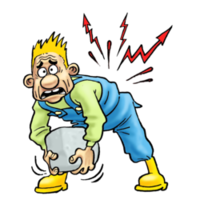Back Pain, The Brain and Pain Cycles

A German research team using a specialized imaging technique called diffusion tensor imaging (DTI) to look at the differences between back pain sufferers’ and healthy volunteers’ brains found that individuals suffering from chronic low back pain also had micro-structural changes in their brains. The findings were presented at the annual meeting of the Radiological Society of North America in Chicago by the lead researcher Dr Jurgen Lutz, a radiologist at Ludwig-Maximilians University in Munich, Germany.
DTI tracks the movement of water molecules in the brain’s gray and white matter. Individual water molecules are constantly in motion, colliding with each other and other nearby molecules, causing them to spread out, or diffuse. DTI allows us to analyze water diffusion in the tissues of the brain. In normal white matter, water diffuses in only one direction. So if they are moving in the “wrong” direction, we can use this as an indication that there are changes in the fiber pathways.
The investigators studied 20 patients who were experiencing chronic back pain with no precisely identifiable cause and 20 age- and gender-matched healthy volunteers. DTI was performed to measure the diffusion in several areas of each patient’s brain.
They discovered the brains of patients with chronic back pain had a more complex and active microstructure compared with the healthy volunteers’ brains.
The changes were found in regions of the brain associated with pain-processing, emotion and stress response, including the cingulate gyrus, postcentral gyrus and superior frontal gyrus.
Although it is possible that theses structural disturbances are a cause of chronic pain, it is more likely to be the other way round.
This leads us to a very important concept that is not talked about as much as it should be: it is the idea of pain cycles. Pain cycles can have a physical or psychological origin and are thought to be maintained by some of the centers in the brain that process pain and emotional distress. The two are often mixed together: pain is extremely common in both depression and in bipolar disorder, and pain can, of course, make you feel depressed.
Theses pain cycles will often persist for long periods after the original cause of the pain has gone. So we may continue to feel pain long after a broken bone has healed, or we may continue to suffer emotionally long after a bad relationship should have been dead and buried. Many interventions like acupuncture or injecting steroids or anesthetics into trigger points can interfere with the pain cycle. Similarly there are many therapies, including some of the tapping therapies, that seem to “re-set” some of the systems in the nervous and subtle systems of the body.
In my forthcoming book Sacred Cycles, I talk a lo about these vicious pain cycles and how to interrupt them.
“Pain is part of being alive and we need to learn that. Pain does not last forever, nor is it necessarily unbeatable, and we need to be taught that.”
–Rabbi Harold S. Kushner (American Rabbi Aligned with the Progressive Wing of Conservative Judaism and Writer, 1935-)
“Softness is a dream in every ache to become a better soul.”
–John Kells (Irish-born British Grand Master of T’ai Chi Ch’uan, 1940-)






